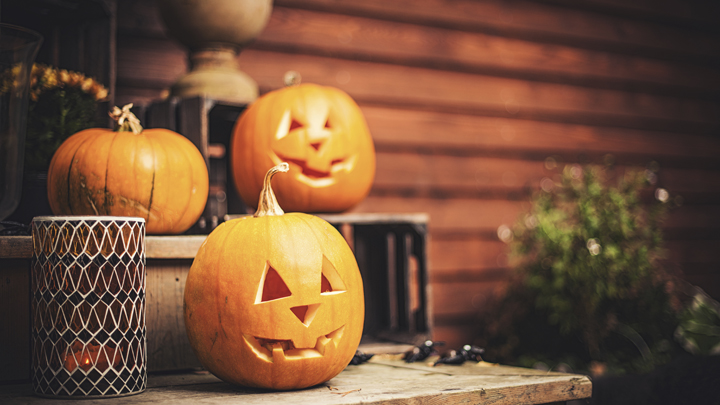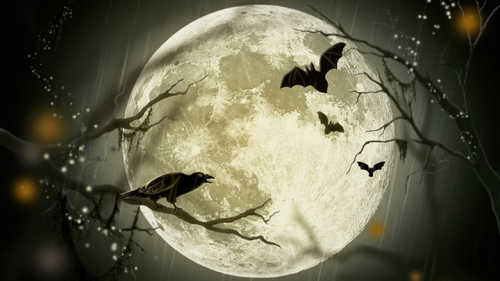Halloween is not evil! The real history of October 31

Do you feel the change in the air all around you? It is growing closer to October 31st when we will celebrate Halloween; the day when the veil between the spirit world and ours, is the thinnest – so they say. The shops are filled with costumes for the little ones to dress up as something frightening, fun or bizarre and go house-to-house trick or treating. Some of us adults dress up too, and have our own Halloween parties. We watch scary movies and indulge in tricks or treats of the adult persuasion. Those of Pagan, Occult and Satanic beliefs have claimed this as their “most important holiday”.
What is Halloween really about? Let’s hop on the magic broom and take a trip back in time to try to understand more of the mystery and history of Halloween.
About 2000 years ago, in the fifth century B.C.. in what is present day Ireland, England and France, a people called the Celts lived and ruled. Life for these people was hard and they depended on nature, she is all they had and all they knew. So, the ending of summer was likened to the ending of human life. The bright, sunny, bountiful days of life and fun ended on October 31, and the onset of autumn, days shortened to long, dark nights of cold and scarcity of food began. What is now Halloween was originally called Samhain (sow-in) the Celtic new year.
The story goes that the Celts believed on the day of Samhain the veil between the spirit world and the living world was the thinnest. They believed that the laws of time and space were suspended for a short period, allowing the spirit world to mingle with the living. It was believed that the spirits of those who had died the previous year were in limbo and that they would come back on this night to possess the bodies of living people for the next year. Their belief was that possessing a living human was their only hope for an afterlife.
Of course, the living did not want to be possessed, so they would extinguish their home fires to make their homes cold and uninviting to roaming spirits. They would wear various masks and costumes of the ghoulish and frightening type to parade around in and be as destructive as possible to scare away spirits looking for living bodies to possess.
A person thought to be possessed by evil spirits, would be burnt at the stake by the Celts. This was thought to teach the spirits a lesson about what would happen to them should they decide to possess a living person.
It was more celebrated in the southern New England colonies such as Maryland, where beliefs and customs from various European cultures and the American Indians meshed, and a distinct version of Halloween began to emerge. Halloween was then celebrated by “play parties”, which were community events, to celebrate harvest time with ghost stories, fortune telling and song and dance.
The lighting and carving of pumpkins, or jack-o-lantern’s, originated from an Irish folk tale. The Irish used turnips for many years as their jack-o-lanterns. When the Irish began coming to America because of the potato famine in Ireland, they found that pumpkins were more bountiful in the new land than turnips. Thus began the use of hollowed out pumpkins as their jack-o-lanterns, which are still popular today.
Trick or treating was not part of the Celtic traditions, but rather from 9th century Europeans, originally called “souling”. November 2nd, All Souls Day, was a day on which early Christians would go from village to village, door to door, begging for “soul cakes,” which were squares of bread and currant berries. The belief being that a soul walked in limbo immediately after death and all prayers, even from strangers, would help the soul into heaven.
Throughout the early 1800s, Halloween was celebrated with singing, dancing, dressing up and parlour games. Young, single women at this time believed that on Halloween they could foretell their future husband’s name. An interesting way to find a man! Compared to online dating and blind dates, there can’t be much more of a margin of error!
By the late 1800s, parents were encouraged to remove any ghoulish or frightening Halloween tales that were of superstitious or religious basis. Through the 1920s and 1930s, Halloween became a community celebration with parades and local parties; and vandalism started to become the rage instead of pranks.
The baby boom during the 1950s revived trick or treating. Because of the large number of children, this was a way to involve the community with each other and the holiday became a “children’s” holiday. Tricks or pranks being played on families could be avoided by providing little treats for neighbourhood children. A new tradition was born and continues to grow today.
Halloween is not evil! Some Pagan groups, occults of various types may have claimed it as their favourite holiday, but it is not an evil day. It comes from Celtic celebration for New Year’s Day. The day, like any other, is only as good or evil as we think it is.
Happy Halloween!
Do you celebrate Halloween? What do you do on October 31? Do you take the grandkids around the neighbour or do you dress up with friends? Tell us below!









 Proudly Australian owned and operated
Proudly Australian owned and operated